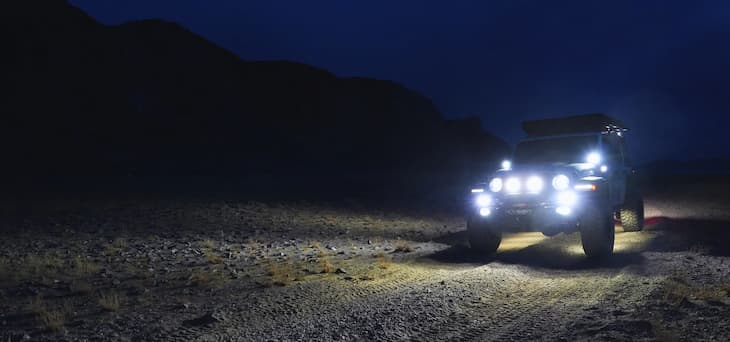Whether it’s on the highway or in the bush, few things are more problematic than driving with weak headlamps. Your ability to see the road, or to be seen by other drivers or pedestrians is more than just a helpful convenience: it’s a matter of both personal and public safety that has to been taken seriously.
All headlamps fade gradually; and depending on the age of your vehicle and globes, and the state of your lenses, your headlamps can plummet to a meagre 20% of their original output before you actually perceive how much they’ve degraded. Your factory headlamps need to be in the best possible condition at all times; but you also shouldn’t exclude installing auxiliary driving lamps for added visibility.
Deciding which auxiliary solution would be the best calls for careful deliberation, though. There are a lot of high quality Australian-made options on the market, and you have to be sure that your choices are aligned with your needs, as well as your state’s driving lamp requirements.
Auxiliary Driving Lights Help You Stay Safe When You’re on the Road

Let’s be honest: while broad spectrum halogen globes still rule the roost when it comes to headlamps, today’s high output auxiliary drive lighting options are better than ever. Not only are these modern auxiliaries engineered to last longer, draw less current, and provide higher luminance than their predecessors, they also feature reflective surfaces that are designed to throw light (illuminate) more effectively than ever.
Whether it’s from the inside or the outside, there powerful auxiliary lighting solutions have everything that’s needed to make vision clearer and driving safer. The IP67-, IP68-, and IP69K-rated lamp housings protect against moisture buildups that could lead to reflector damage and voltage fluctuations, and detachable polycarbonate coloured, and spectrum filters even give you the freedom to fine tune colour hues and beam patterns to safely minimize the likelihood of wearying eye fatigue, or of blinding oncoming vehicles.
These Factors Matter the Most When You’re Shopping for Auxiliary Lights
In most instances, a maximum of up to four, symmetrically positioned auxiliary lights can legally be fitted onto any vehicle in Australia, including onto rooftops if they’re mounted on the front half of the vehicle. There are, however, three factors that you have to consider when trying to decide which drive lighting type is going to suit your needs the best:
· The auxiliary’s size. Although the amount of available space you have is most likely to dictate the size of your auxiliary lighting’s housings, they should never be so large that their luminance causes either direct or reflective discomfort, or their placement in any way interferes with your field of view.
· The auxiliary’s shape. From classic oval- and rectangular-shaped housings, to lengthy, low-profile light bars, you’ll find auxiliary driving lights for sale ranging from extra-slim 240mm dishes to lightweight light bars equipped with either single or dual rows lights in lengths from 10” – 50”.
· The lamp’s colour temperature. Driving lamp colour temperatures, measured in degrees Kelvin (K) and raw light output lumens, will typically range from a warm, subtly toned 3000K light that minimizes eye strain, to a cool, almost bluish 5000K light which, while being markedly brighter, can potentially cause annoying eye fatigue in short order.
In a country where driving across large swathes of unsealed, as well as unlit territory isn’t uncommon, auxiliary ute and car driving lights are an essential part of being able to travel safely at night. And Australian Design Rules (ADRs) are incredibly accommodating to these forward-facing headlamp helpers.
As long as they’re mounted and wired in accordance with your state’s specific guidance, buying driving lights online is an option that you always have to keep open. And when it comes to choosing the right light sources, you’re not just limited to halogen globes anymore; you can also look at HIDs and LEDs.
Recognizing Which Type of Auxiliary Globe Can Offer You the Most Value

Make no mistake: it doesn’t matter if you’re talking about special fixtures like spotlights or floodlights, or more conventional illumination like headlamps and drive lights, the science behind automotive driving lights is an evolving technology. And as the likes of High Intensity Discharge (HID) and Light Emitting Diode (LED) sources have emerged to compete with classic halogen auto drive lights, globe innovations have been the biggest driver behind the increase in auxiliary lighting options.
With applicable voltage ranges between 10V – 30V, all three types of auxiliary driving globes have benefited substantially from improvements in coatings, electronics, and materials, helping to make them both brighter and energy efficient. Looking into them in more detail:
· Halogen lights now exceeding 2000 hours of lifespan. These modern lights for sale are still the lowest price lighting alternative, but they’re almost twice as bright as previous generations of halogens, and are capable of delivering a 3300K/2800 raw lumen beam per pair to 1 lux at a distance of 994m.
· HID lights cost noticeably more than halogens, but depending on the application, not only can their latest generation be counted on to last up to 3000 hours, but their extreme luminescence 5000K/14,322 raw lumen driving spotlight beams can produce 1 lux at a distance of over 2500m per pair.
· LED lights have the highest initial cost of all auxiliary globes, but with almost no energy lost to wasted heat. As such, these driving lamps can last up to an astounding 30,000 hours, and are able to maintain their full per pair intensity of 5000k/15,540 raw lumen output throughout their full lifespan to 1 lux at over 1119m.
You can even buy driving lights in HID and LED hybrid 5000K/8400 raw lumen combinations that offer superior performance, reduced glare, and better heat management, all while producing 1 Lux at over 1650m. They’re the perfect balance of HID’s long distance illumination and LED’s light spread, giving you the best of both worlds when looking for the longest lasting solution with the bright light.
The Final Word
At the end of the day, auxiliary lamps aren’t just for off roading, hunting, and other niche automotive activities. They’re basic safety accessories if you live in a remote area or do a lot of nighttime driving on unlit regional roads, so you have to choose them wisely.
Fortunately, the range of today’s high output auxiliary drive light options is broader, more effective, and more efficient than it’s ever been. And along with always having a few spare globes in your vehicle at all times, they’re the best way to keep your nighttime driving safe for everyone.



















